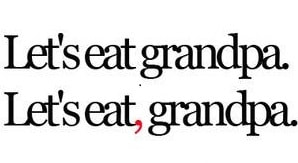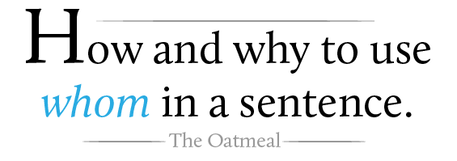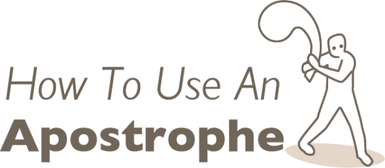 Even in this age when text is often reduced down to 140 characters or less, don’t forget the punctuation. It just could save a life! I recently went to visit my boys at their summer camp. While driving near Algonquin Provincial Park, I saw a handmade sign posted on a front lawn that read “Slow Kids Crossing.” I was so distracted by the sign (do they mean their kids are physically or mentally slow?) that I could have accidentally hit someone. It is safe to assume they intended “Slow, Kids Crossing” (or “Slow Down, Kids Crossing” would have been better), but this example goes to show the power of punctuation. The lack of punctuation in this sign obscured the intended meaning. For those of us who notice this sort of thing, it can be annoying—and sometimes amusing. Lynne Truss, author of Eats, Shoots & Leaves: The Zero Tolerance Approach to Punctuation, says: “We are like the little boy in The Sixth Sense who can see dead people, except that we see can see dead punctuation.” The comma is especially complicated because it plays a grammar role, but also a role as an indicator of the rhythm and flow of the sentence. It is also the most controversial punctuation mark. People have very strong opinions about the Oxford (or serial) comma, but I will leave that heated topic for another post (there has already been enough bloodshed). The comma indicates a slight break between different parts of a sentence. The function of the comma is to group together words, phrases, and clauses to make a sentence clearer to read. The effect of a misplaced or omitted comma can be quite comical at times. Here are some examples from 25 Biggest Comma Fails on BuzzFeed:
Commas with relative clauses
 A trick to make sure you have used the commas correctly is to take the information enclosed by the commas out from the sentence and see if the sentence still makes sense and conveys the meaning you intended. Commas with dependent clauses Commas with introductory words and phrases
Commas with independent clauses Commas with parenthetical and descriptive phrases
I hope you learned something from this very general introduction to using the comma. Stay tuned for a separate post in which I will discuss the use of the comma in lists.
Happy Adventures in Editing!
0 Comments
The question came up today about when to use who versus whom. Let us seek the answer from The Oatmeal. They provide far more entertaining answers to grammar questions than I could offer (I am just not that inspired by the apostrophe). Check out the links below. Do you agree? Is the semicolon the most-feared punctuation on Earth?
|
AuthorI am freelance copy editor, proofreader, and instructor based in Toronto. Enjoy my adventures in editing! (Note: I transferred my blog over and lost my comments along the way, unfortunately. Please add new ones.) Archives
October 2017
Categories
All
|














 RSS Feed
RSS Feed